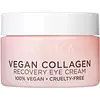What's inside
What's inside
 Key Ingredients
Key Ingredients

 Benefits
Benefits

 Concerns
Concerns

 Ingredients Side-by-side
Ingredients Side-by-side

Water
Skin ConditioningCetearyl Olivate
Caprylic/Capric Triglyceride
MaskingCetearyl Alcohol
EmollientGlycerin
HumectantSorbitan Olivate
EmulsifyingGlyceryl Caprylate
EmollientGlyceryl Stearate Se
EmulsifyingSr-Hydrozoan Polypeptide-1
HumectantChamomilla Recutita Flower Extract
MaskingCalendula Officinalis Flower Extract
MaskingCitrus Aurantium Dulcis Flower Extract
Skin ConditioningRosmarinus Officinalis Leaf Extract
AntimicrobialHydrolyzed Brassica Napus Seedcake Extract
Skin ConditioningJasminum Officinale Flower Extract
MaskingArnica Montana Flower Extract
MaskingLeuconostoc/Radish Root Ferment Filtrate
AntimicrobialCamellia Oleifera Seed Oil
Skin ConditioningHydrolyzed Jojoba Esters
Skin ConditioningCaffeine
Skin ConditioningAllantoin
Skin ConditioningPanthenol
Skin ConditioningSodium Hyaluronate
HumectantTocopherol
AntioxidantQuartz
AbrasiveOpuntia Ficus-Indica Seed Oil
EmollientArginine
MaskingBentonite
AbsorbentCoconut Alkanes
EmollientCoco-Caprylate/Caprate
EmollientCetyl Esters
EmollientStearic Acid
CleansingCetearyl Glucoside
EmulsifyingXanthan Gum
EmulsifyingMaltodextrin
AbsorbentGlucose
HumectantPhenoxyethanol
PreservativePotassium Sorbate
PreservativeSodium Benzoate
MaskingWater, Cetearyl Olivate, Caprylic/Capric Triglyceride, Cetearyl Alcohol, Glycerin, Sorbitan Olivate, Glyceryl Caprylate, Glyceryl Stearate Se, Sr-Hydrozoan Polypeptide-1, Chamomilla Recutita Flower Extract, Calendula Officinalis Flower Extract, Citrus Aurantium Dulcis Flower Extract, Rosmarinus Officinalis Leaf Extract, Hydrolyzed Brassica Napus Seedcake Extract, Jasminum Officinale Flower Extract, Arnica Montana Flower Extract, Leuconostoc/Radish Root Ferment Filtrate, Camellia Oleifera Seed Oil, Hydrolyzed Jojoba Esters, Caffeine, Allantoin, Panthenol, Sodium Hyaluronate, Tocopherol, Quartz, Opuntia Ficus-Indica Seed Oil, Arginine, Bentonite, Coconut Alkanes, Coco-Caprylate/Caprate, Cetyl Esters, Stearic Acid, Cetearyl Glucoside, Xanthan Gum, Maltodextrin, Glucose, Phenoxyethanol, Potassium Sorbate, Sodium Benzoate
Water
Skin ConditioningCaprylic/Capric Triglyceride
MaskingStearyl Alcohol
EmollientCarthamus Tinctorius Seed Oil
MaskingPolyglyceryl-2 Stearate
EmulsifyingButyrospermum Parkii Butter
Skin ConditioningTheobroma Cacao Seed Butter
EmollientJojoba Esters
EmollientSodium Ascorbyl Phosphate
AntioxidantPyrus Malus Fruit Extract
Skin ConditioningCaffeine
Skin ConditioningSodium Hyaluronate
HumectantHelianthus Annuus Seed Oil
EmollientCamellia Sinensis Leaf Extract
AntimicrobialArginine
MaskingCaprylhydroxamic Acid
Squalane
EmollientEthylhexyl Olivate
Skin ConditioningGlycerin
HumectantPropanediol
SolventSodium Gluconate
Skin ConditioningCetearyl Phosphate
Skin ConditioningCI 77891
Cosmetic ColorantCI 77491
Cosmetic ColorantCetyl Hydroxyethylcellulose
Emulsion StabilisingMica
Cosmetic ColorantCaprylyl Glycol
EmollientCitric Acid
BufferingWater, Caprylic/Capric Triglyceride, Stearyl Alcohol, Carthamus Tinctorius Seed Oil, Polyglyceryl-2 Stearate, Butyrospermum Parkii Butter, Theobroma Cacao Seed Butter, Jojoba Esters, Sodium Ascorbyl Phosphate, Pyrus Malus Fruit Extract, Caffeine, Sodium Hyaluronate, Helianthus Annuus Seed Oil, Camellia Sinensis Leaf Extract, Arginine, Caprylhydroxamic Acid, Squalane, Ethylhexyl Olivate, Glycerin, Propanediol, Sodium Gluconate, Cetearyl Phosphate, CI 77891, CI 77491, Cetyl Hydroxyethylcellulose, Mica, Caprylyl Glycol, Citric Acid
Ingredients Explained
These ingredients are found in both products.
Ingredients higher up in an ingredient list are typically present in a larger amount.
Arginine is an amino acid that is important for human development. Your body uses is it to produce hair keratin and skin collagen.
As a cosmetic ingredient, Arginine has antioxidant properties and can also help repair damaged skin. This ingredient is derived either synthetically or from animals.
Arginine isn't fungal acne safe when used in the presence of other lipids (fats, fatty acids, oils, esters, etc). Oils and fats occur naturally within the skin, so take caution when using Arginine if you're prone to fungal acne.
Learn more about ArginineCaffeine is most associated with coffee, tea, and cacao. In skincare, it helps with calming inflammation and is rich in antioxidants.
While caffeine is used to treat cellulite and and dark circles, further studies are needed to prove this. It has been believed to help with these skin conditions due to its ability to dilate blood vessels and increase blood flow.
Some studies are looking into caffeine's ability to protect against UV rays.
Learn more about CaffeineThis ingredient is an emollient, solvent, and texture enhancer. It is considered a skin-softener by helping the skin prevent moisture loss.
It helps thicken a product's formula and makes it easier to spread by dissolving clumping compounds.
Caprylic Triglyceride is made by combining glycerin with coconut oil, forming a clear liquid.
While there is an assumption Caprylic Triglyceride can clog pores due to it being derived from coconut oil, there is no research supporting this.
Learn more about Caprylic/Capric TriglycerideGlycerin is already naturally found in your skin. It helps moisturize and protect your skin.
A study from 2016 found glycerin to be more effective as a humectant than AHAs and hyaluronic acid.
As a humectant, it helps the skin stay hydrated by pulling moisture to your skin. The low molecular weight of glycerin allows it to pull moisture into the deeper layers of your skin.
Hydrated skin improves your skin barrier; Your skin barrier helps protect against irritants and bacteria.
Glycerin has also been found to have antimicrobial and antiviral properties. Due to these properties, glycerin is often used in wound and burn treatments.
In cosmetics, glycerin is usually derived from plants such as soybean or palm. However, it can also be sourced from animals, such as tallow or animal fat.
This ingredient is organic, colorless, odorless, and non-toxic.
Glycerin is the name for this ingredient in American English. British English uses Glycerol/Glycerine.
Learn more about GlycerinSodium Hyaluronate is hyaluronic acid's salt form. It is commonly derived from the sodium salt of hyaluronic acid.
Like hyaluronic acid, it is great at holding water and acts as a humectant. This makes it a great skin hydrating ingredient.
Sodium Hyaluronate is naturally occurring in our bodies and is mostly found in eye fluid and joints.
These are some other common types of Hyaluronic Acid:
Learn more about Sodium HyaluronateWater. It's the most common cosmetic ingredient of all. You'll usually see it at the top of ingredient lists, meaning that it makes up the largest part of the product.
So why is it so popular? Water most often acts as a solvent - this means that it helps dissolve other ingredients into the formulation.
You'll also recognize water as that liquid we all need to stay alive. If you see this, drink a glass of water. Stay hydrated!
Learn more about Water